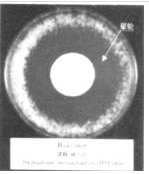Classification of textile antibacterial performance test methods
The test of antibacterial properties of textiles is divided into quantitative test methods and qualitative test methods, and quantitative test methods are the most important.
1.Quantitative test method
At present, the quantitative test methods and standards for antibacterial properties of textiles include the American AATCC Test Method lO0 (bacterial number determination method) TZ/TO2021-9, Quinn (Quinn) experimental method and the like.
Quantitative testing methods include disinfection of fabrics, inoculation of test bacteria, culture of bacteria, counting of residual colonies, and the like. It is suitable for non-dissolving antibacterial finishing fabrics and is not suitable for dissolution-based antibacterial finishing fabrics. The advantages of this method are quantitative, accurate and objective, and the disadvantages are long time and high cost. Fig. 1 is an example of the results of the test for the number of bacteria.

2. qualitative test methods
The qualitative test methods mainly include AATCC Test Method 9O (Halo Test, also called agar plate method), AATCC Test Method 124 (parallel scribing method), and JIS Z2911-1981 (antimicrobial test method).
Our company introduces 3Q series of fungicides, preservatives, fungicides, environmentally friendly and formaldehyde-free, mainly used in industrial circulating water treatment of petrochemical, electric metallurgy, paper industry, wood industry, coating industry, leather industry, daily chemical industry and metal cutting. Sterilization, anti-corrosion and anti-mildew in liquid and other industries.




